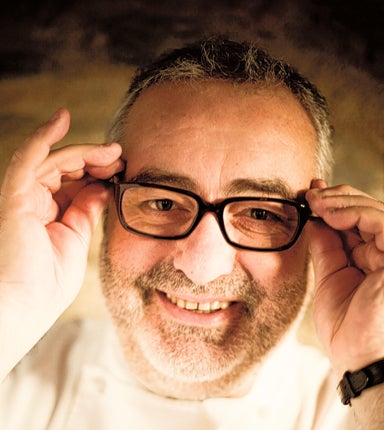Santi Santamaria: Michelin-starred chef who provoked outrage when he attacked the school of 'molecular gastronomy'

The Catalan chef, Santi Santamaría, who died of a suspected heart attack in Singapore, was only 53. He was the first Catalan chef to win three Michelin stars for his Barcelona restaurant, Can Fabes, but his fame was eclipsed by the headline-grabbing capacity of his compatriot, Ferran Adrià. The latter is currently the most celebrated chef on the planet; at his El Bulli he has revolutionised cooking, being the foremost exponent of what (for lack of a better expression) is called "molecular gastronomy."
Santamaría, who seemed to relish controversy, first attacked Adrià in January 2007, at the annual tourist board-sponsored summit meeting called "Madrid Fusion," where he called the molecular cooks "a gang of impostors whose work is to distract snobs." Though he seemed a bit stung by Adrià's growing celebrity (three stars, the cod-title of "best restaurant in the world," a visiting lectureship at Harvard), he kept his keen sense of humour. In his 2007 onslaught, this careful, proud craftsman reminded his audience that even the best meals "end with a good shit."
Eighteen months later, when receiving an award for his own book La Cocina al Desnudo (The Kitchen Laid Bare), he grumpily said, "Some chefs offer a media spectacle and are not concerned about healthful eating", and went on to say: "Ferran and I have an ethical and conceptual divorce over what we put on the plate." To an audience that included the Spanish minister for culture (some sources say the intended hearer was the minister of health), he railed at "the use of chemical substances like methylcellulose," saying it was "a public health risk" and invited the authorities to do something about it.
Spain was not always the country of fine food. Indeed, its rise to the gastronomic heights is very recent and, truth to tell, it was a decade behind the rest of Europe in learning to make the most of its plethora of great ingredients. In fact, Spain's restaurants were dire, with paella and gazpacho the chief tourist alternatives to expensive, often overcooked fish.
Santamaría had no formal training as a chef. Born in 1957, he trained as an industrial engineer. In 1981, however, while the nouvelle cuisine was beginning to spread like a rash over the face of France, Santamaría opened his Can Fabes in the Sant Celoni farmhouse where he and at least two earlier generations had been born. It was rustic, not much more than a tavern, and served simple, agrestic dishes such as sausages with white beans. But then he discovered Juan Mari Arzak's new take on Basque cuisine at his restaurant in San Sebastián, and became aware of what was happening just across the border.
The Japanese influence on presentation so evident in France now made its mark on his cooking and especially serving, as he began to plate up the food in the kitchen, like all ambitious chefs the world over. He got his first Michelin star in 1988, and the third in 1994. The farmhouse gave way to a chic, modern restaurant with luxury rooms (though the website boasts that it is "the smallest Relais & Château in the world"). His menu now credits the additional names of Àngels Serra & Xavier Pellicer, and their publicity says: "Devotion to the country and its people permeates the restaurant and the menus at Can Fabes, where natural, seasonal, local produce plays a leading role. But Can Fabes' commitment to its roots is also a commitment to modernity, apparent from the menu cover, designed by the great Catalan painter Antoni Tàpies." In practice, modernity meant much use of the colours orange and red; and his cooking was applauded for melding Catalan flavours with French techniques.
He was in the forefront of the current trend of ethical sourcing, and insisted on the produce of "organic farming, traditional fishing. Fish from Blanes, mushrooms and lamb from the Montseny, truffles from Osona, peas and strawberries from the Maresme, rice from the Ebro delta, game out of the hunter's pouch." You can get an idea of his culinary style from the "amuse bouches" on his set menu: "Iberian cured ham from Extremadura, wild mushroom flan, razor clams with herbs and goat-milk curd with kumquat honey" – the only concession to today's foodie globalisation being the kumquat honey.
Santamaría was evidently a good businessman, for at the time of his death he had parleyed the three-star ex-farmhouse/tavern into an empire of eight luxury eateries, two in Madrid, two in Barcelona, one in Toledo and one in Dubai. At the time of his death he was with his daughter, at his restaurant Santi, in Marina Bay SandsResort in Singapore; he was promoting the new facility to the international press, and had participated in a press conference with his fellow chefs Mario Batali, Guy Savoy, Daniel Boulud,Wolfgang Puck and Australia's Tetsuya Wakuda.
He was also well known in America, thanks to the enthusiasm there for foodie Spaniards. But in the rest of Europe he will be remembered as much as a controversialist as a chef-entrepreneur. Only days after his anti- Adrià outburst Eurotoques, a European professional chefs' body, rebuked what it called his "act of aggression," and some normally jolly Spanish chefs went on the attack. Sergi Arola, a Madrid chef, accused Santamaría of speaking "out of envy", while Andoni Luis Aduriz, of the two-star Mugaritz, told the New York Times, "Santi is the Hugo Chavez of gastronomy. He loves to spark controversy with his populist talk." Adriá allowed himself to speculate about the injury Santamaría's comments would do to Spanish cuisine's reputation abroad.
Paul Levy
Santi Santamaría, chef and businessman: born Sant Celoni, Catalonia 26 July 1957; died Singapore 16 February 2011.
Join our commenting forum
Join thought-provoking conversations, follow other Independent readers and see their replies
Comments